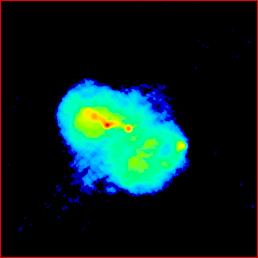 Image:
Image:3C 346 | B1641+173 |
| S178 | Alpha | FR | Class | ID | Spectrum | Best z | mag. | LAS | lg P178 | D |
|---|---|---|---|---|---|---|---|---|---|---|
| 11.9 | 0.52 | I | SB+HB | Gal | 0.161 | R(c) = 16.48 | 17.00 | 25.67 | 40.8 |

| Size: | 25.6 × 25.6 arcsec² |
|---|---|
| LUT: | Logarithmic |
| Beam: | 0.35 arcsec |
| Frequency: | 1534 MHz |
| Method: | CLEAN/VTESS’ėˇ>0.35
|
| Telescope: | MERLIN/VLA |
| Credits: | Leahy (1997), Akujor & Garrington (1995). |
Optical/UV emission from the jet was discovered by Dey & van Breugel (1994), and the HST image by de Koff et al. (1996) shows that the jet appears very similar in the optical and radio bands. About two arcsec from the core the jet appears to bend suddenly by about 65°. The point is marked by a knot about sixty times brighter than anywhere else on the jet, presumably produced by the shocks which must occur when a supersonic flow is suddenly bent. In fact, the shocks needed for a 65° bend ought to make the flow subsonic (Williams 1991) and would probably disrupt the jet; so the bend angle is probably exaggerated by forshortening.
Radio polarimetry by Akujor & Garrington (1995) shows that the magnetic field in the jet is generally parallel to the axis, except for a short section just downstream from the knot where the field is transverse. The lobes show a strong Laing-Garrington effect.
VLBI observations by Cotton et al. (1995) resolved the core-jet structure of the compact core, and detected the bright jet knot.
The bright and sharply-curved jet, strong Laing-Garrington effect, small projected size, fat lobes, and unexpected faint extensions, are all consistent with this being a DRAGN seen rather close to the jet axis, so that the jet is enhanced by relativistic beaming, the lobes and jet are seen extremely forshortened, and typical faint central distortions appear in projection outside the main axis. A fly in the ointment is that there is no sign of the broad lines in the optical spectrum (e.g. Dey & van Breugel 1994) that we would expect according to unified schemes if we are looking down the throat of an AGN. It is also unlikely that a combination of beaming and projection could hide a strong hotspot on the jet side; in other suspected cases of "end-on" DRAGNs the jet-side hotspot is extremely bright (e.g. 3C 303). More likely, from a larger angle 3C 346 would resemble 3C 401.
Because at high-resolution 3C 346 is dominated by the core and the nearby jet knot, it has been included in the sample of compact steep-spectrum sources studied in van Breugel et al. (1992) and earlier papers by the same team. In fact the existence of emission on scales larger than the few arcsec characteristic of true CSS objects has been known at least since Pooley & Henbest (1974), and 3C 346 cannot be considered a CSS in any meaningful sense.
The faint fine-scale detail in the diffuse lobes of our high-resolution
image is mainly
due to a mixture of noise
and artifacts produced by the
core and bright jet knot. In particular, the apparent brightness minima in
the lobes surrounding each of these features are probably artifacts;
the dip in brightness is only about 0.5% of the peaks.
| Prev. | Data Page | Other images | Next | Search | Alphanumeric List | Icon List | Atlas Index |
|---|